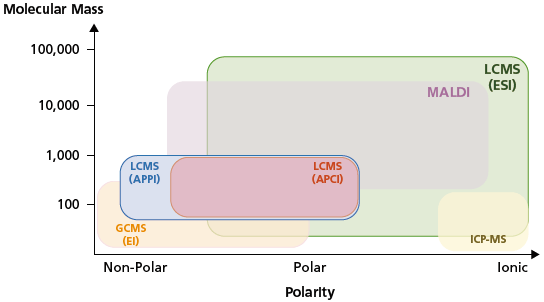Comparison of LC/MS and GC/MS Techniques
Liquid Chromatography/Mass Spectrometry (LC/MS) and Gas Chromatography/Mass Spectrometry (GC/MS) are two widely used techniques for analyzing compounds. This page compares their principles, ionization methods, and best-use scenarios to help you select the right tool for your analysis.
Apart from LC/MS, there are various ionization techniques and analytical instruments for chemical analysis such as Inductively Coupled Plasma MS (ICP-MS), Matrix-Assisted Laser Desorption/Ionization (MALDI-MS) and electron ionization (EI) with gas chromatography MS (GCMS), MS was first introduced and used as a detector for GC systems in late 1960s and their advantages have been widely recognized.
Principal Differences Between LC/MS and GC/MS
| Feature | LC/MS | GC/MS |
|---|---|---|
| Sample Type | Polar | Volatile, thermally stable, non-polar/low-polar |
| Mobile Phase | Liquid | Gas |
| Ionization | ESI, APCI, APPI | EI, CI |
How GC/MS Works
- Requires volatile samples
- Mostly uses electron ionization (EI)
- Suitable for non/low-polar, low-molecular compounds
GC separates volatile compounds in a column where the mobile phase is an inert gas and the stationary phase is either a packed column or a coated liquid. The compounds are retained and separated based on their polarity, volatility (boiling point) and their interaction with the stationary phase. After separation and elution from GC, the compounds undergo a hard ionization (i.e. electron ionization (EI)) to form gaseous ions and are further analyzed by MS. Today, GC/MS technologies provide a very effective means for separating, qualifying and quantitating substances, but its applicability is limited to gases or volatile compounds with relatively low molecular mass, and samples with high thermal stability (Figure 4).

Figure 4. Common ionization techniques (APCI, APPI, EI, ESI, MALDI and ICP) and their range of applicability.
How LC/MS Works
- Suitable for polar compounds
- Uses ionization such as ESI, APCI, or APPI
- Wider range of applications than GC/MS
LCMS was only made possible in mid-1970s with the introduction of atmospheric pressure ionization (API). With the use of API, the LC eluent vaporizes and ionizes to form gaseous ions, which are subsequently introduced into the MS. API is a type of soft ionization technique and examples include atmospheric pressure photoionization (APPI), atmospheric pressure chemical ionization (APCI) and the commonly used electrospray ionization (ESI). These ionization techniques are discussed in greater detail in Chapter 2. Unlike GCMS, one of the advantages of LCMS is its broad applicability to a wide range of compounds (Figure 4). Once the sample is dissolved in a mobile phase, LCMS can analyze even the least volatile or thermally unstable compounds that are difficult to analyze using GCMS.
Other ionization techniques such as ICP and MALDI were later introduced in the mid-1980s. ICP-MS is frequently applied for elemental analysis while MALDI, a soft ionization technique, is commonly used for large molecules analysis (e.g. proteins, peptides and polymers). In summary, with the introduction of API techniques, LCMS provides broad applicability for an extensive range of substances (e.g. polar and nonpolar) and offers high selectivity.
When to Use LC/MS vs GC/MS
GC/MS is ideal for environmental or forensic labs where volatile compound detection is critical. LC/MS is more suitable for pharmaceutical analysis, biomolecule detection, and complex matrices.
FAQ
What’s the main difference between LC/MS and GC/MS?
GC/MS analyzes volatile, thermally stable compounds, while LC/MS is suitable for polar compounds.
Can LC/MS replace GC/MS?
No. Each method is optimized for different compound types. They are complementary.


